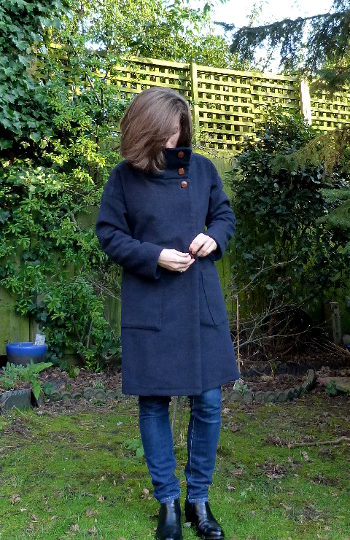Hello everyone ! Today I am talking to you about the plants I have chosen to grow in my little dye garden. I will also show where I will put them. This article is part of a series of articles on how to create a small dye garden where I invite you to follow the creation of mine. In my previous article I told you about my motivations and how I documented myself on the subject.
The choice of dye plants for a little dye garden
How to choose the plants for your dye garden? Many times I have read that you have to start small, with 3-4 plants. I’m not particularly a garden expert (even if I’m the daugther of a talented gardener!), I don’t have unlimited time to spend, I don’t know how to make natural dyes yet, and I don’t want to become overwhelmed by all this… That being said I don’t think I want to limit myself to 3-4 plants! If my plantations make beautiful flowers and I don’t use them to make dyes, then they will have made beautiful flowers and that’s already very good!
To select the plants I will grow, I simply worked by color. I wondered what shades I wanted to get? First of all blue, my favorite color! Then red, yellow, pink, brown, green. All the colors actually! 🙂
Big list of dye plants
So at the beginning I made a long list of dye plants that I found interesting for their dye colours. I made the list using my book “Wild colors” and different blogs/websites/Instagram pages.
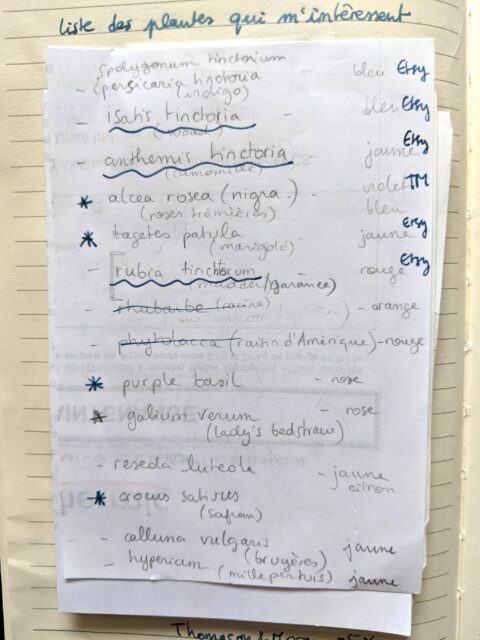

The difficulty for me was to find my way between the names of plants in English, French and Latin! But the plant’s official language is Latin, so in my final list I call them by their Latin nickname with their French name in brackets. It’s also easier to buy them, no matter where you are on this planet.
Where to buy dye plants ?
After writing my long list, I searched where I could get seeds/seedlings of all these plants. At first, I wanted to buy everything in one place for simplicity, cost and to limit the carbon footprint of my purchases. However it is not that simple! At least it helped me reduce my list, because many plants are not available, difficult to find (crocus sativus (saffron) bulbs for instance). When I found only one plant available in an online store, I stopped looking in that shop. Eventually, I found my seeds in two stores, physical and online. For seedlings, I will get them from a third shop.
I went to B&Q for a different reason (a big UK DIY shop), I found packets of dye plant seeds in the garden section. You can therefore find a few varieties of dye plants in DIY / garden centers or nurseries, even if the choice is limited.
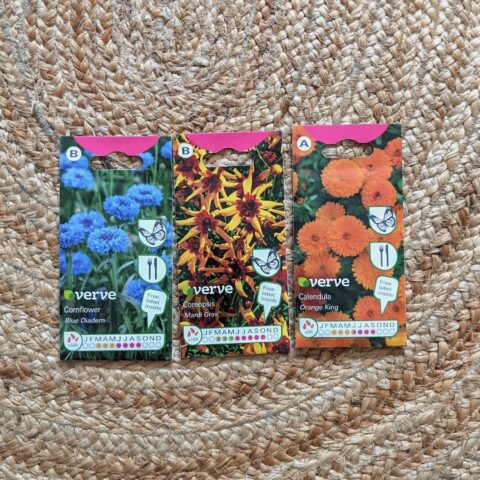
While doing my research on the internet, I found a lot of seeds on Etsy (!). At first I was a little surprised to find these seeds on the biggest handmade marketplace, I realised that designers of naturally dyed products simply resell their seeds and offer most of the varieties you need to make your own dye garden. They are above all dye specialists, not nurseries. Mine were sold by a collective of creative craftspeople based in England, and they sell naturally dyed textiles and seeds (The Outside Dyer).
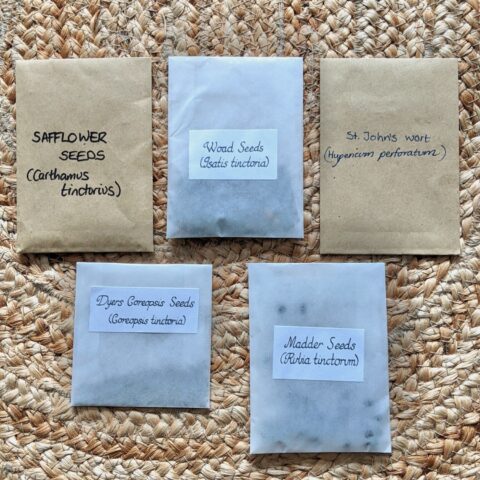
In what form to buy?
By that I mean, seeds or seedlings? First of all, it is according to what you can find. But also, for some varieties, it is ideal to find plants already in pots, to have a harvest and get dye material as soon as possible. This is what I will do for the alcea rosea (hollyhocks) which can be planted as early as March, otherwise you have to wait until the following year to have the first flowers. Same for the rubia tinctorum (madder) whose roots only turn red after 2 years, I’ll see if I can find some in pots, but this is less likely.
List of dye plants chosen for my small dye garden
Here is my selection of dye plants by dye colour:
Blue :
- Isatis tinctoria (woad) > seeds
- Centaurea cyanus (cornflower) > seeds
Violet blue:
- Alcea rosea (hollyhocks) > seedlings
Pink :
- Carthamus tinctorius (safflower) > seeds
- Ocinum basilicum (red basil) > seedlings
Red :
- Rubia tinctorum (madder) > seeds and seedlings
- Hypericum perforatum (St. John’s wort) > seeds
Yellow / orange-yellow:
- Coreopsis tinctoria (elegant coreopsis) > seeds
- Calendula officinalis (marigold) > seeds
- Carthamus tinctorius (safflower) > seeds
- Hypericum perforatum (St. John’s wort) > seeds
Green :
- Carthamus tinctorius (safflower) > seeds
- Hypericum perforatum (St. John’s wort) > seeds
Some varieties are present in several colours because a different color can be obtained depending on the dye extraction method and/or the part of the plant used. This is the case with safflower and St. John’s wort, according to my book “Wild Colour”.
Where will I grow my dye plants?
How to create a space for dye plants in your garden? This is perhaps where I should have started the article, because you must first study the available space before purchasing many plants! The majority of dyeing plants love the sun so you have to find a sunny spot for them. Then, I read on plant growing instructions that it is best to space the plant 20-30cm apart, so with your available space in mind, you can guess how many plants you can plant.
Our garden faces north, but we get quite a bit of sun especially in front of our garden shed, well when it’s not raining (remember, I live in London!). The photo below was taken in winter, when the sun is at its lowest, and it is in the sunny part that I decided to install my small dye garden.

I could have planted everything in pots to make things easier for myself, but I have decided to create a large grow bed so that I could plant in the ground. Thus the plants will have more resources when it is drier. In pots you need to water more often.
My father helped me a lot with the design and the works. Removing block paving and doing masonry work to create the plant bed walls, that required muscles!
We first hand drew a plan of the garden (and below using my Procreate app) and then we drew the future grow beds in chalk directly on the ground.
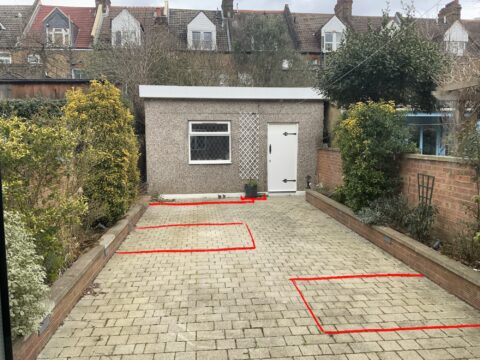
I would like to create other planters to put other plantations and create movement but we first took care of the one near the shed.
Then my father worked hard to remove the block paving and reuse it to make the walls of the grow beds.

Here is my beautiful finished grow beds:
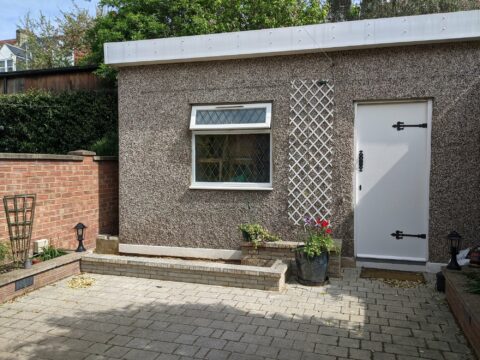
Now I just have to order a big bag of soil (it takes almost 1m3 of soil!), fill my plant beds, and grow the plants! Actually in the next article I’ll talk to you about how I’m going to grow all this…


